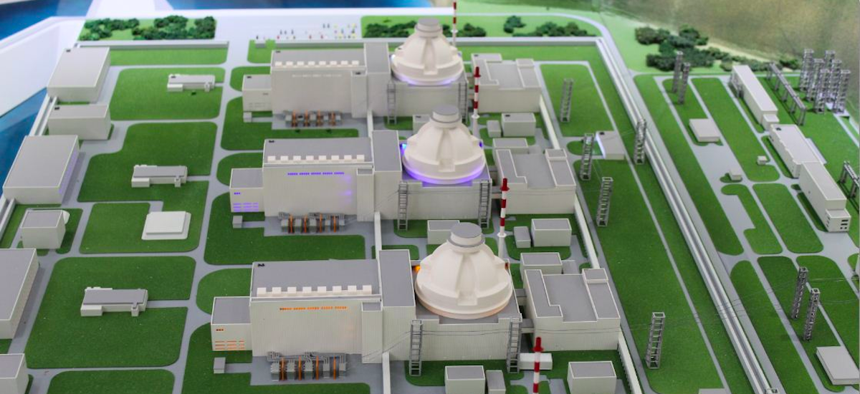
A model of the Akkuyu Nuclear Power Plant in Mersin, Turkey. AKKUYU NÜKLEER A.Ş. VIA VOICE OF AMERICA
How Russia, China Use Nuclear Reactors To Win Global Influence
It starts when state-sponsored nuclear-power companies underbid Western competitors.
Russia and China are using nuclear power projects to build spheres of energy dependence, and the United States is unprepared to respond.
In April, Turkey broke ground on its first nuclear power plant, which the government says will help meet the country’s rapidly growing demand for electricity and increase its energy independence. In reality, the project may make Ankara much more vulnerable to Kremlin influence, as the plant will be built, owned, and operated by Russia.
The Akkuyu reactor shows how Russia — and now China — are using energy exports to build influence abroad. Russia bids for such projects through its state-owned nuclear company, Rosatom, under a model that finances construction of nuclear plants, furnishes the trained personnel to run them, and leases them back to the client country. Kremlin subsidies allow Rosatom to underbid competitors by 20 to 50 percent, while government-to-government loans can help woo countries that might otherwise have difficulty paying for such projects. This has allowed Russia to secure 60 percent of recent global nuclear reactor sales; Rosatom is currently has 35 reactors in 11 countries under construction or contract.
Although Rosatom’s business model decreases customer costs, it hands Russia influence that extends well beyond the energy sector. In Turkey, Russia is working with the government to draft the nuclear regulations that will apply to its own projects, running the risk of regulatory capture. In Hungary, the relationship between Victor Orban's government and the Kremlin has warmed since Moscow stepped in to finance a nuclear plant expansion that will supply 40 percent of the country’s electricity. Russian control of major sources of electricity, as well as the presence of Russian technical and security personnel on the nuclear project site, gives Moscow leverage over a country’s security and foreign policy decisions.
Now China is taking a page from Russia’s handbook. The Chinese government sees nuclear power as a potentially powerful component of its Belt and Road Initiative (BRI), which aims to economically and politically integrate China with Europe, Africa, and the rest of Asia through major infrastructure projects—such as developing nuclear power in energy-dependent countries.
Chinese firms are constructing nuclear plants in Romania, Pakistan, and the United Kingdom, with others to be built in Argentina and Iran—and the list of projects could expand substantially. The chairman of the China National Nuclear Cooperation, a Chinese nuclear vendor, has identified 41 countries along the Belt and Road as potential sites for nuclear power projects. China also aims to establish long-term contracts for the construction and operation of nuclear plants, and captures new markets by covering upfront costs and providing technology and construction services. Beijing is covering 82 percent of the reactor costs in Pakistan, and 33 percent of the United Kingdom’s Hinkley Point project.
These projects come with more than a monetary price tag. China in particular has a history of using predatory lending practices to make strategic gains. Last year, when Sri Lanka could not pay the debts it owed to Chinese companies for infrastructure projects, it was forced to sign over control of the major port of Hambantota to Beijing. China may expand this tactic to make political or territorial gains in key parts of the world by leveraging nuclear power plant debts.
Meanwhile, U.S. nuclear companies find it nearly impossible to compete against government-backed competitors motivated by political goals more than profit. The state-owned nuclear companies of China and Russia are directly lobbied for by top leaders—Vladimir Putin has aggressively promoted Rosatom’s bids abroad, including those in the Middle East and South America. Russia has also used other forms of soft power to promote its nuclear presence abroad, including funding youth competitions in Africa and building a research center in Bolivia. Without this form of state support, U.S. companies find themselves at a disadvantage as they try to sell their product to foreign governments.
In addition, U.S. nuclear exports are severely limited by restrictive export laws and an inefficient and complicated export control process. While maintaining nonproliferation standards is critical to safeguarding global peace, the stringent conditions of these agreements and export controls make U.S. technology far less appealing to other countries than technology from Russia or China, which comes with fewer strings attached. Creating hurdles for U.S. exports will not prevent the adoption of nuclear technology by interested countries, but it will remove the United States from a role in which it can help guide the development of nuclear power and monitor for proliferation concerns.
Despite the barriers it faces, the U.S. nuclear industry is still regarded as the leader in nuclear power technology, and can compete if given a fair playing field. The Trump administration has pledged to revitalize the U.S. nuclear energy industry— todo so, it should guide its companies by streamlining and clarifying the export process and by serving as a global advocate on behalf of its industry.
China and Russia’s steps to dominate global nuclear power create a major security vulnerability for the United States and pose a threat to the international order. Nuclear energy can be a powerful element of U.S. foreign policy, but if the United States continues to opt out of this arena, Washington will be handing a powerful foreign policy tool to others to wield.



